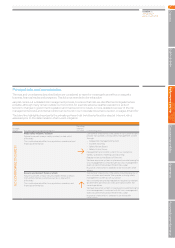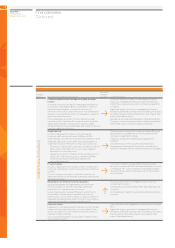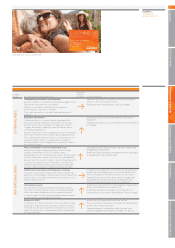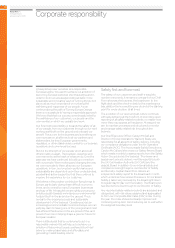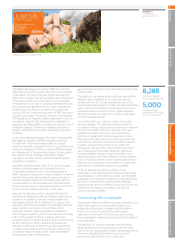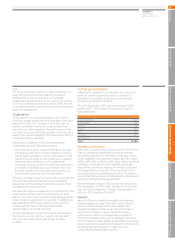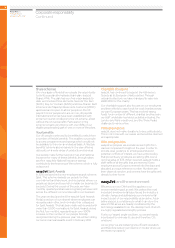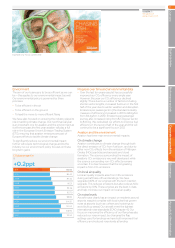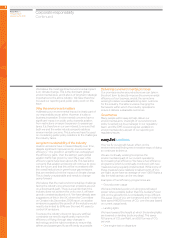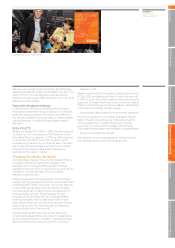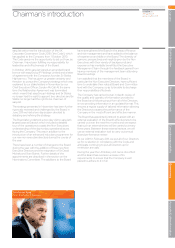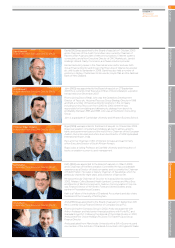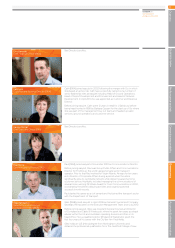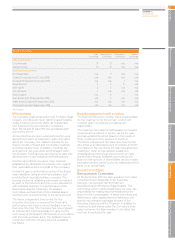EasyJet 2011 Annual Report Download - page 39
Download and view the complete annual report
Please find page 39 of the 2011 EasyJet annual report below. You can navigate through the pages in the report by either clicking on the pages listed below, or by using the keyword search tool below to find specific information within the annual report.
easyJet plc
Annual report
and accounts 2011
Corporate responsibilityPerformance and risk
Overview Business review Governance Accounts & other information
37
Environment
The aim of our business is to be as efficient as we can
be – this applies to our environmental impact as well.
Our environmental policy is governed by three
promises:
– To be efficient in the air
– To be efficient on the ground
– To lead the move to more efficient flying
We have also focused on ensuring the industry plays its
role in tackling climate change. Our next financial year
is an important one for aviation and the environment as
it will encompass the first year aviation will play a full
role in the European Union's Emission Trading System
(ETS), ensuring that aviation emissions are part of
Europes efforts to tackle climate change.
To significantly reduce our environmental impact
further will require technological change across the
industry, so our environment policy focuses on these
long-term gains.
+0.2ppt
2009
2010
2011
CO2/passenger Km
g
84.60
84.40
87.30
2007
2006
2005
2004
2003
2002
2001
2008 90.31
95.56
95.70
98.80
104.50
110.00
106.90
112.50
Progress over time and environmental data
– Over the last ten years easyJet has successfully
improved our CO2 efficiency every single year.
However, this year our CO2 efficiency declined
slightly. This is due to a number of factors including
shorter sector lengths, increased fuel burn in the first
half of the year due to winter weather and disruption.
Emissions per passenger km (the standard industry
measure of efficiency) increased in 2011 to 84.6g/km
from 84.4g/km in 2010. Emissions per passenger
journey also increased, rising from 82.3 kg per sector
to 84.6 kg. We redoubled our efforts to improve fuel
efficiency in the second half of the year and this will
continue to be a significant focus in 2012
Aviation and the environment
Aviation has three main environmental impacts:
On climate change
Aviation contributes to climate change through both
the direct emission of CO2 from fuel burn, and due to
other non-CO2 effects from the emission of Nitrogen
Oxides (NOx), particles and aerosols and cloud
formation. The science surrounding the impact of
aviation’s CO2 emissions is very well developed, while
the science surrounding non-CO2 effects remains
uncertain. It is clear however that the long-lasting
impact is from CO2 emissions.
On local air quality
Local air quality impacts arise from NOx emissions
during aircraft take-offs and landings. We have
upgraded 40% of our engines with the tech insertion
upgrade. This reduces emissions but also reduces NOx
emissions by 10%. These engines are the best in class
and help minimise our impact on local air quality.
On noise levels
Aircraft noise clearly has an impact on residents around
airports. easyJet complies with local rules that govern
noise at airports (such as curfews and routeings to
avoid built up areas). Our aircraft meet the tightest
international noise standards [ICAO chapter 4]. Our
focus on improving the efficiency of our flying has also
reduced our noise impact; by changing the flap
settings used for landings we have both improved fuel
efficiency and reduced noise levels at landing.
Example only. Not a current offer.


